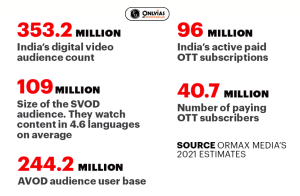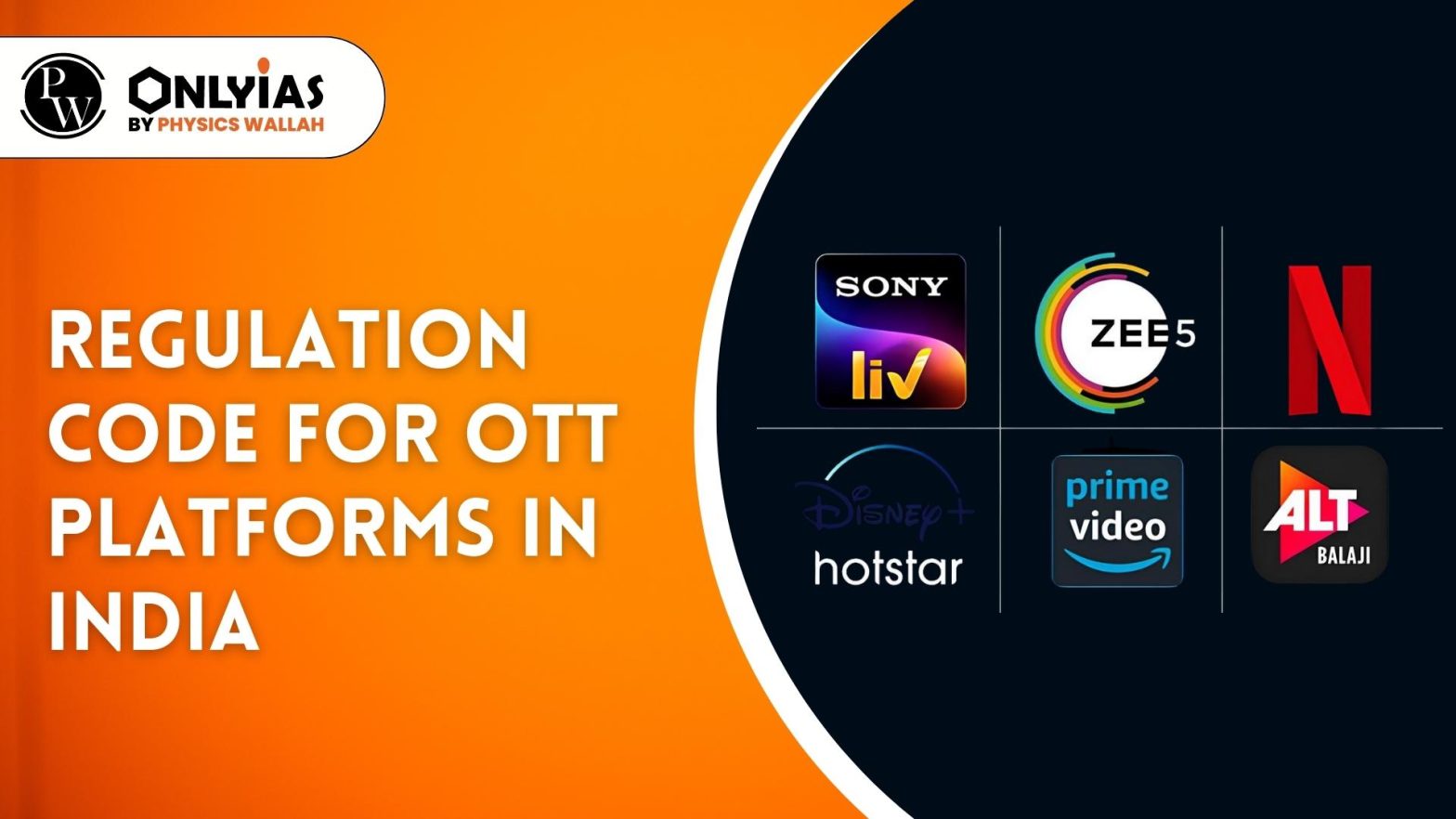Context:
| Relevancy for Prelims: OTT Platforms, OTT services, Ministry of Information and Broadcasting (MIB) and TRAI.
Relevancy for Mains: Regulations on OTT Platforms, Indian Telecommunication Bill, 2022, and Conflict Between TSPs and OTTs. |
Content vs. Communication: Regulatory Scope for OTT Platforms in India
- Discussion on selective banning of OTT services initiated after a Parliamentary Standing Committee’s notice to DoT.
- Concerns arose due to unrest caused by widely-used OTT communication platforms.
- Scope of Consultation:
- Consultation paper exclusively addressed OTT communication services (e.g., WhatsApp, Signal, Meta, Google Meet, Zoom).
- Over-the-top (OTT) communication services refer to services that provide real-time person-to-person telecommunication services.
- Not applicable to ‘content’ OTT platforms like Netflix and Amazon Prime, as content regulation falls under the Ministry of Information and Broadcasting (MIB).
- TRAI’s Inquiries:
- TRAI asked stakeholders to provide definitions of OTT.
- Also sought proposals on cost-sharing mechanisms between Telecom Service Providers (TSPs) and OTT services.
What are the OTT platforms?
- OTT platforms, or over-the-top platforms, refer to audio and video hosting and streaming services that have evolved from content hosting platforms to creators and distributors of various types of content. Here are key characteristics of OTT platforms

- Notable examples of OTT platforms include Netflix, Amazon Prime Video, Disney+, Hulu, HBO Max, and many others.
- Current Regulation of OTT Platforms in India:
- As of now, there are no specific laws or rules regulating OTT (Over-The-Top) platforms in India.
- These platforms, considered digital media or social media, have operated with little to no government regulation, unlike traditional media such as television, print, or radio.
What are the pros and cons of OTT platforms?
| Pros |
Cons |
- Low cost
- Multi-Platform service
- Original content
|
- Availability of Internet connection.
- Poor network can affect viewing
- Online security
|
Why regulations are needed for the OTT platforms?
- Conflict Between TSPs and OTTs: The key points of contention are:
- Regulation and Charges:
- TSPs argue that OTT platforms in India should be subject to regulation and fees because they heavily rely on the existing telecom infrastructure developed by TSPs over the years.
- Currently, OTTs operate without specific regulations and charges in place.
- Revenue Erosion:
- TSPs claim that OTT communication services have resulted in a decline in their revenue streams.
- This shift in consumer behavior has led to a significant reduction in revenue for telecom companies.
- Regulatory Parity: TRAI contends that telecom operators and OTT platforms, like WhatsApp, provide similar services but are subject to different regulatory requirements.
- Licensing Requirements: Telecom operators are required to obtain service licenses for offering voice and SMS services.
- In contrast, OTT communication service providers offer voice calls, messaging, and video call services without holding similar licenses.
- Legal Framework: Telecom service providers in India are governed by various laws, including the Indian Telegraph Act, 1885, the Wireless Telegraphy Act, 1933, and the Telecom Regulatory Authority of India Act, 1997.
- These laws establish legal frameworks that govern telecom operators’ operations, including requirements such as lawful interception, which do not currently apply to OTT platforms or services.
- Financial Contribution: TRAI notes that OTT platforms do not make financial contributions to support the expansion of telecom services in the country.
- In contrast, telecom operators are obligated to contribute to the Universal Service Obligation Fund (USOF), which is aimed at promoting telecom services penetration in underserved areas.
- National Security and Public Order: OTT platforms should be subject to lawful interception and monitoring by security agencies to prevent the dissemination of misinformation, incitement of violence, or facilitation of criminal activities.
ALSO READ: INFORMATION TECHNOLOGY
What are the challenges in regulating OTT platforms?
- Volume and Accessibility: The sheer volume of content on OTT platforms and its on-demand nature make monitoring and regulation complex.
- India’s OTT viewership stands at 43 million people and is projected to rise up to 50 million by the end of 2023.
- Media Freedom Concerns: Regulation efforts have faced backlash due to concerns over media freedom, with critics fearing it could stifle free speech and expression.
- Differences from Traditional Media: Digital content differs significantly from conventional media, covering more liberalized and diverse themes, and challenging conventional censorship paradigms.
- Foreign Content and Enforcement: Regulating content from foreign countries poses enforcement challenges, leading to concerns about piracy.
- Increasing Legal Challenges: Producers of web series and films face legal challenges and petitions for content removal, adding to the complexity of regulation.
- Ex., the makers of the web series Tandav were charged with offenses under the IPC,6 and the IT Act.
What are the possible solutions for OTT platforms?
Demand from Telecom Service Providers (TSPs):
- Policy Framework for Fair Contribution:
- TSPs are calling for the establishment of a policy framework that ensures fair and proportionate contributions from large OTT service providers to telecommunication network operators.
- The contribution should be based on assessable criteria such as the number of subscribers or data usage.
- Support for Network Expansion and Exchequer Contribution: The funds collected from OTT platforms should be used to support the expansion and improvement of telecommunication networks.
|
- Hybrid Governance Model: A hybrid model that involves self-regulation by industry stakeholders could be considered. It involves:
- Independent Self-Regulatory Body: Establishing an independent self-regulatory body comprising industry stakeholders to address grievances and complaints related to OTT content.
- Appeal Mechanism: Recommendations by the self-regulatory body can be appealed before an appellate committee with independent members.
- Quasi-Judicial Body: The final level of regulation could involve a quasi-judicial body with industry experts and judicial members, whose decisions would be conclusive.
- Speedy Resolution: Such a structure aims to ensure speedy resolution of content-related issues and reduce the burden on higher courts.
- Unbiased Regulatory Body for OTT Content: To address the current scenario, there is a pressing need for an impartial regulatory body to oversee content on OTT platforms.
- Draft Indian Telecommunication Bill, 2022:
- Inclusion of OTT Communication Services: The current draft of the Bill proposes expanding the definition of “telecommunication services” to encompass OTT communication services.
- Licensing Parity with TSPs: This expansion would mean that OTT communication services may face the same licensing conditions as Telecom Service Providers (TSPs).
- Unified Access Service Licence (UASL): TSPs are required to hold a Unified Access Service Licence (UASL) to provide telecom services in India.
- Implications for OTT Communication Services: If OTT communication services are mandated to obtain the same UASL, they would also be subject to various conditions, including;
- Maintaining ‘know your customer’ (KYC) details of their users.
- Compliance with encryption regulations.
Conclusion
The evolving landscape of OTT platforms in India necessitates a balanced regulatory approach, addressing the concerns of telecom operators while safeguarding media freedom. The proposed hybrid governance model and the draft Indian Telecommunication Bill, 2022, reflect ongoing efforts to establish a comprehensive framework for the regulation of OTT communication services, ensuring fair contributions and licensing parity with traditional telecom services.
| Attempt the PY Prelims Question
In India, which of the following reviews the independent regulators in sectors like telecommunications, insurance, electricity, etc.? (2019)
- Ad Hoc Committee set up by the Parliament.
- Parliamentary Department Related Standing Committee.
- Finance Commission.
- Financial Sector Legislative Reforms Commission NITI Aayog
Select the correct answer using the code given below.
- 1 and 2
- 1, 3 and 4
- 3, 4 and 5
- 2 and 5
Ans: A |
![]() 6 Oct 2023
6 Oct 2023


